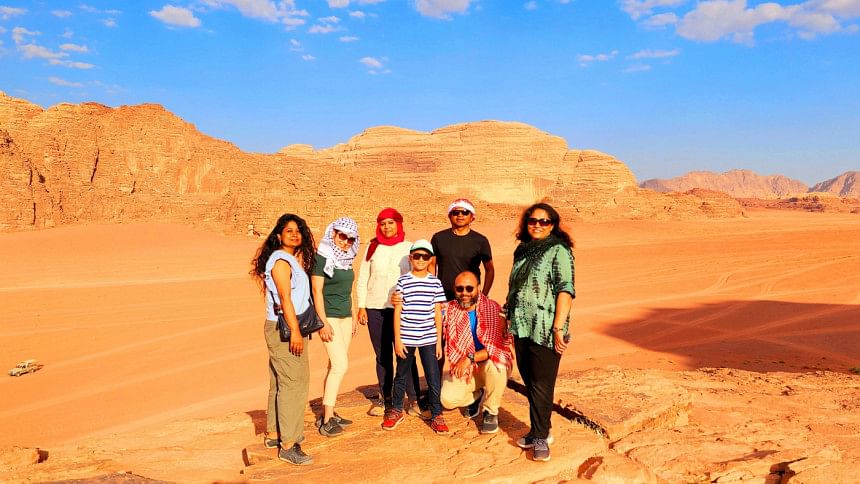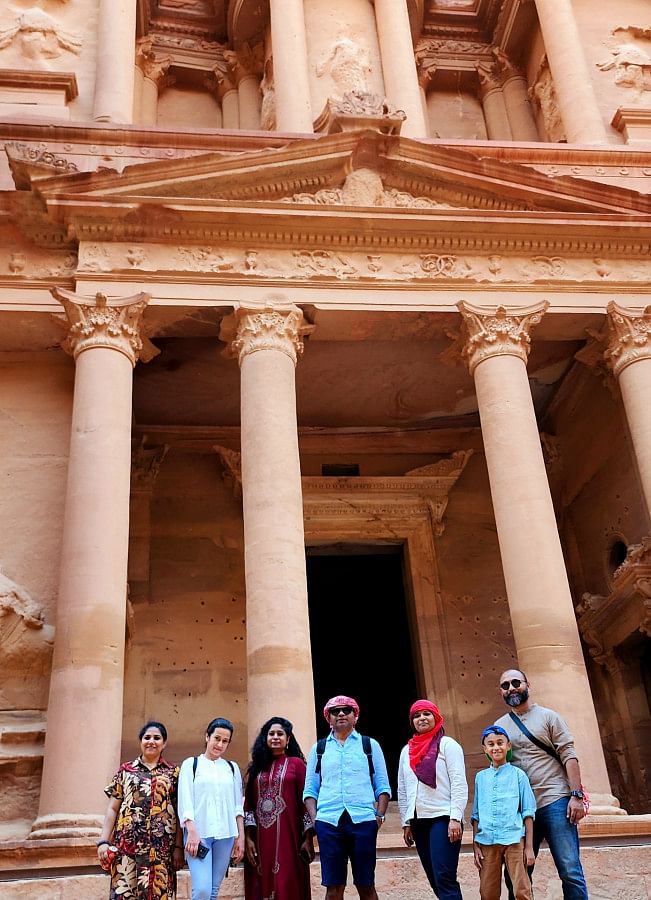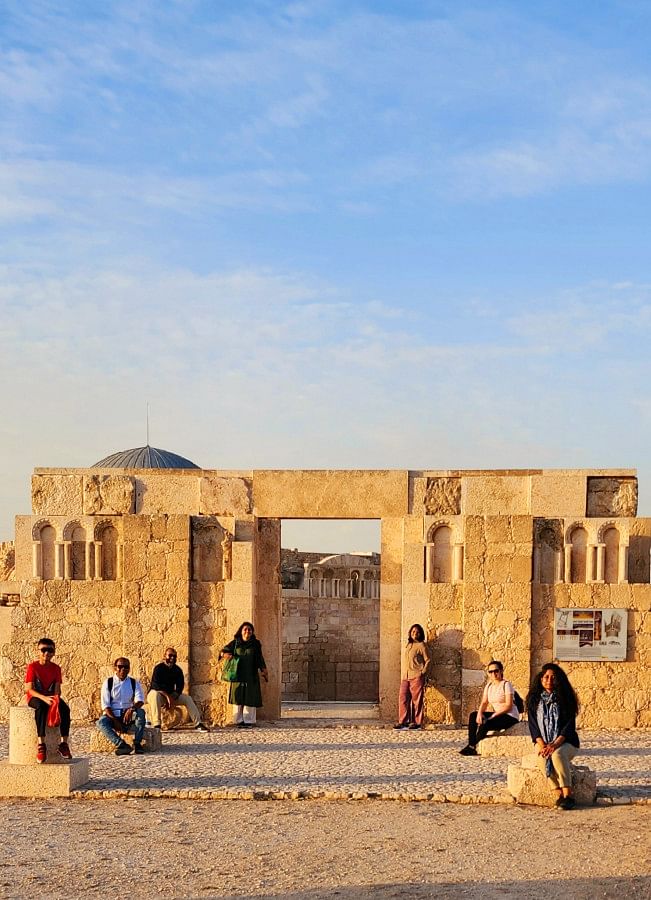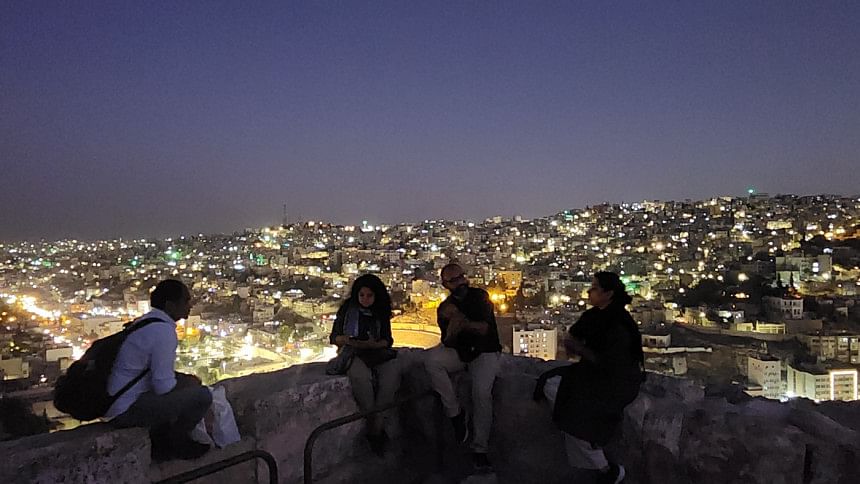Exploring Jordan: From Petra to the Dead Sea

The first name that comes to mind when we talk of Jordan is the world-famous Petra, one of the new Seven Wonders of the world. But this small landlocked country in the Middle East has much more to offer with its natural wonders like the Dead Sea and Wadi Rum, and its numerous historic places dating back to the ancient Roman civilization, the early days of Islam and the lives of our Prophets. What can be a better travel destination for history buffs?
After the wearingly long COVID lockdowns, my plan was to travel at least two new countries in 2023. With GOBDGO, our travel partner over the last 10 years, we planned the trip spanning two countries in two continents. With lots of customizations and last-minute changes, aptly managed by GOBDGO, we finally left Dhaka in October for our three-week long tour. Jordan was our second destination.

After landing in Amman, our travel agent welcomed us from the immigration counter in Queen Alia International Airport. Jordan is the first country we have been to where the locally currency is stronger than the US Dollars (for 100 US Dollars, you get 70 Jordanian Dinar!). But that was the only sad part of our 11-day stay in Jordan.
Your tour in Jordan has to start with Petra, the 'Rose City' built by the Nabateans more than 2,500 years ago. A major trade hub in those days, the entire city has been carved out of red sandstone mountains in Wadi Musa or the Valley of Moses, covering an area of over 260 sqkms. On any given day, Petra is visited by over 3,500 tourists. So, to have the best views of the place without the mad rush of people, we woke up at four in the morning, had early breakfast (thanks to the hotel we stayed in), and reached the gates of Petra by 6.45am. From there, you need to walk through the 1.2km gorge, the Siq, to reach the most popular spot in Petra – Al Khajneh or the Treasury building. The one-hour walk is an experience in itself as you get to see ancient caves, temples and statues of gods and goddesses carved out of the mountains along both walls of the narrow Siq. The Treasury Building is the only building that stands today without any damage from the earthquakes that destroyed most parts of Petra, and the whole structure has been carved out of a single sandstone mountain. You can climb up on some of the nearest hilltops to get an aerial view (and some splendid shots) of the Treasury building. While many people turn back from there, Petra has a lot more to offer. Our group divided into two – four team members decided to climb the 1,000 stone steps to reach the monastery on top of a hill, while me, my friend and her kid decided to explore the ruins of houses and temples in the remaining parts of Petra. After walking and hiking for over an hour in the intense heat and dust (head and face cover is a must), we decided to rest for a bit in one of the nearby caves (Petra has many). As we climbed up to the cave and looked inside, we were dumbfounded to see that the cave is actually the home of a Bedouin family! The lady of the house, who spoke fluent English, graciously invited us inside the beautifully decorated place, offered us tea, and told us we are free to walk around her house. From her, we came to know that there are 35 Bedouin families who still live in the caves of Petra, that they go to the nearby village every day to bring food and water, and their children go to the village school. We rested there for almost an hour, sipping the tea and watching her kids play while taking in the beautiful view of the Petra valley from the mouth of the cave. We spent close to ten hours in Petra, but this unplanned visit to a Bedouin home was just the cherry on the cake.

Even after a whole day of walking, hiking and climbing up the rocky, dusty mountains, we wanted to have more of Petra. So, we went back just after a few hours to enjoy 'Petra by Night' – a light show at the Treasury Building (separate entry tickets are needed for this). With hundreds of candles lighting up the narrow Siq and a night-time sky flooded by a full moon, Petra had transformed magically into a strange, mysterious place from thousands of years back. While the light show lasted for less than half an hour, the walk through the Siq at night was an experience worth having.
The next day, we went to Little Petra – a smaller suburb to the main Petra city. With much less crowd, we took our time to visit the houses and caves here. But the main attraction of Little Petra are the cats – extremely friendly cats of all size, shape and color. I spent most of my time in Little Petra running after these cats.
Our next destination was Wadi Rum – the valley of the moon, which lies near the borders with Saudi Arabia. While having lunch at a restaurant overlooking the Wadi, it seemed like we were waiting at the gates of Mars – as the granite and sandstone mountains with their strange shapes looked nothing like anything we had seen before. The landscape has been the backdrop of many popular films over the years, including the 1960's classic Lawrence of Arabia, to the more recent Dune, the Martian, John Wick, Star Wars: The Rise of Skywalker, Aladdin, Prometheus and many more. The best way to experience Wadi Rum is in an open-top Jeep speeding through the sand trails. We spent an eventful four hours climbing up the red sand dunes as high as 7-storeyed buildings, riding camels across the valley, climbing up rock formations for panoramic view of the terrain, or looking for ancient rock inscriptions giving directions to the trade caravans through the desert, or depicting hunting warriors and various animals. It is possible to spend a night in Wadi Rum in the Bedouin tents for stargazing and to take in the nighttime beauty of the valley.

Another highly recommended place is the tree of Al Buqayawiyya – the Blessed Tree. Dating back 1,500 years and located in the old trade route between Mecca and Damascus, it is believed that the Prophet Muhammad (pbuh) rested underneath this tree while travelling with his uncle Abu Talib, and this is the place where the Monk Bahira foretold about his future as the last Prophet. Even without this part of history attached to it, the tree itself is a wonder of nature – a Pistachio tree full of green leaves, standing in the middle of a desert terrain with no other plants or trees for miles around, with birds and butterflies flying around its leaves and branches.
Jordan has a host of other locations that are worth the visit for their historic and religious significance. There is Mt Nebo from where the Prophet Moses was granted a view of the promised land before his death. On a very clear day, the golden top of the Dome of the Rock of Al Aqsa mosque is visible from the summit of Mt Nebo. We really hoped to have a glimpse of the sacred place; however, we were not so lucky. There is Ain Musa (near Wadi Musa), or the Moses Spring, believed to have been formed by the Prophet Moses after striking the rock with his staff whereby water gushed out from- the rock for his followers to drink from. The spring flows even today, covered by a simple structure with three domes that represent Islam, Christianity and Judaism. A 20-minute drive from Amman will take you to the Cave of the Seven Sleepers, popularly believed to the cave described in Sura Kahf in the Holy Quran (although both Turkey and Syria claim location of similar caves in their respective countries). Even without the religious significance, the cave is an interesting place for visitors. Then there are the 12th century castles of Ajloun, Shobak and Kerak – testament to the battles fought and won by Sultan Saladin against the crusaders. While some castles are in ruins, some are in remarkably good conditions and definitely worth a visit. The ruins of Jerash just outside Amman also provide interesting glimpses from the Roman era.
Our last stop was the Dead Sea, the lowest point on Earth and a natural salt-lake with such high salinity that there are no fishes, plants or living creatures in the water. With salinity level 10 times higher than any other ocean, nothing drowns in the water. You do not need to know how to swim to enjoy the blue water of the lake. With salinity levels 10 times higher than any other ocean, you cannot drown in the water even if you try! After witnessing a beautiful sunset, we spent some more time in one of the many restaurants lining up the shores. Just on the other side of the lake are the cities of Jericho and the West Bank, and a bit further, Jerusalem. With the events unfolding in those regions even as we were visiting, the stark contrast between the two sides of the Dead Sea and its significance was not lost on us.
We spent the last two days in Amman. It is recommended to stay in downtown Amman as all major tourist spots from both the Roman and Islamic era are within walking distance. One day is enough to visit the Roman Amphitheatre, the ruins of the Ummayad Palace, Byzantine Basilica and the Temple of Hercules. The hilltop Roman Citadel is a prominent sunset point, and we stayed back even after the sunset to enjoy the panoramic view of the city all around us as it slowly lit up in colorful lights.
While Amman has its own upscale neighborhoods and shopping malls, the soul of the city is in downtown Amman. You should take your time to stroll through the old city's colorful and ever-busy souks and road-side stalls with the colorful 'Tatreez' dresses, Oud perfumes, traditional jewelry and local crafts. There are many beautifully decorated restaurants or the bustling road-side stalls where you can enjoy the delicious kebabs, Mansaf, Makloubeh, Hummus with Pita Bread, Falafel. But no visit in Amman is complete without tasting the Knafeh of Habibeh Sweets – hands down the best dessert from the Middle East. The Rainbow Street in Amman is also highly recommended, especially at night, with its colorful strip brimming with creative cafes, restaurants, and shops – a popular destination of tourists and locals alike.
But no description of Jordan is complete without talking about the people. Most of the shopkeepers in downtown Amman, as well as our tour guides and driver, were of Palestinian descent, whose parents or grandparents came to Jordan as refugees and stayed there. Their warm-hearted and generous treatment overwhelmed us, and every time we said we are from Bangladesh, they thanked us for always being a friendly state to the Palestinians. Hearing about their stories and their struggles had a humbling effect on us all. We will always fondly remember Captain Mahmoud, who drove us around the country; Mr. Afridi, our friendly tour guide with his extraordinary gift of storytelling; Mr. Adnan, the owner of a boutique whose honesty and hospitality moved us. All of them are originally from Palestine.
Out of the 30+ countries I have visited, Jordan now holds a special place in my heart. A highly recommended country for anyone who is interested in history and nature. And I would definitely like to go back there again someday.
Zurat Haque is working as Head of Rewards & Operations , People & Culture at JT International Bangladesh Limited. She is a travel enthusiast.

 For all latest news, follow The Daily Star's Google News channel.
For all latest news, follow The Daily Star's Google News channel. 



Comments